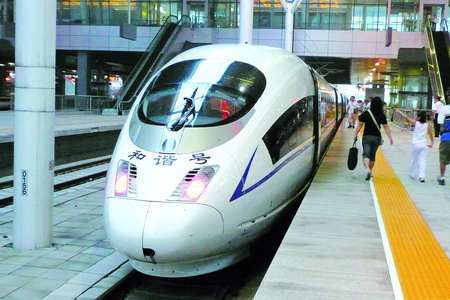| 
The high-speed railway between Beijing and Tianjin has carried 18.7 million passengers since it was inaugrated on August 1, 2008.
The sales volume of a century-old Tianjin baozi restaurant chain, Goubuli ("Go Believe") has increased by over 20 percent since the high-speed Beijing-Tianjin Intercity Rail began operation last year, according to Li Yongshan, general manager of Tianjin Goubuli Baozi Co. Ltd..
"Increasingly more people are coming, many from Beijing," Li told the Global Times. "In fact, we're so busy with customers that it was hard to keep the carpet clean so we changed to hard wood flooring."
The first high-speed railway independently developed by China, with a speed of 350 kilometers per hour, celebrated its first anniversary on August 1. It carries 18.7 million passengers in the past year between Beijing and Tianjin and the number of passengers between the cities rose by 86 percent after it opened for service.
"China has entered a high-speed railway era and created enormous social and economic benefits for the Bohai Sea economic circle," said Zhang Shuguang, deputy chief engineer of the Ministry of Railways.
The travel time was shortened from 90 minutes to 30 between the cities.
Since its inauguration, representatives from more than 30 countries and regions including the US, Britain, Russia and Japan have come to inspect the railway, with some expressing a desire to work with China to build some in their native lands.
The train brings out of town day-trippers as well. The daily traffic of Tianjin's Ancient Culture Street has increased to 60,000 people and 150,000 during holidays, up by 15 percent overall after the train began running.
"I'm surprised that so many visitors come to Tianjin by high-speed railway and the visitors are so interested in the market," said Zhao Kuojiang, the deputy director of the Tianjin Committe of Commerce. "It's made our various economic indicators grow so fast."
"The sales volume has risen at least 30 percent since the railway began. If shoppers are carrying 5100 spring water (a brand only sold on the intercity rail), we know they are from Beijing," said Jiang Ruiyun, a manager of an ancient Culture Street store known for its nut snacks.
A young woman surnamed Li who works in a shop that sells Chinese clay figurines said the sales volume has also grown by 30 percent thanks to the railway. "More than 10,000 people visit our store every day. Visitors from Beijing always spend a large amount of money on shopping," she said.
A tourist guide named Shi Lei from Beijing Youth Travel Service told the Global Times he leads tour groups from Beijing to Tianjin via the railway at least twice a week.
"The number of tour groups has tripled since last year," Shi said. "Visiting Tianjin by intercity high-speed rail has been a big selling point."
In 2008, the sales volume brought by visitors to Tianjin surpassed 75 billion yuan ($11 billion) and the intercity railway contributed to 35 percent of the increase. During the first half of this year, the retail sales for consumer goods jumped to 117.6 billion yuan ($17.22 billion), up by 20.7 percent from the same period last year, ranking the second of growth rate in the country, according to the Tianjin Committe of Commerce.
Li Hongchang, vice president of School of Economics and Management in Beijing Jiaotong University, pointed out that despite the influence of economic crisis, GDP of Beijing and Tianjin still saw a big increase over last year.
"I attribute the boom to the operation of the Beijing-Tianjin Intercity Railway. It not only promotes close economic contacts between these two cities, but also boosts consumers' confidence," Li said.
Editor: Guo Changdong |

